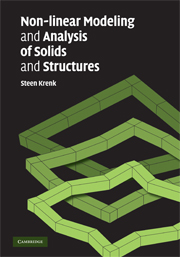Book contents
5 - Co-rotating beam elements
Published online by Cambridge University Press: 05 June 2012
Summary
The beam theory of Chapter 4 and the corresponding finite element implementation was formulated in a fixed global frame of reference using the total displacements and rotations. In many cases it may be advantageous to consider the beam element with reference to a local, element-based, coordinate system. Motion of the beam then implies motion of the local frame of reference as well as deformation of the beam element within this frame. The separation of the motion of the element into two parts – a rigid body motion associated with the element-based frame of reference and a deformation of the element within this frame of reference – is called a co-rotating formulation. The co-rotating formulation has a number of advantages, provided it can be demonstrated that the tangent stiffness can be decomposed into the sum of a part associated with the rotation of the element-based frame and a part associated solely with the deformation of the element within this frame of reference. The first advantage is that displacements and rotations within the local frame of reference are small or at most moderate. Therefore, the deformation of the beam can be modeled by approximate beam theory. Secondly, the co-rotating formulation is closely associated with the idea of ‘natural modes’, advocated by Argyris et al. (1979a,b). The idea of the ‘natural modes’ is to consider any increment of the motion of an element as made up of a set of rigid body modes – typically translation and rotation – and a set of deformation modes – representing extension, bending and torsion of the beam element.
- Type
- Chapter
- Information
- Non-linear Modeling and Analysis of Solids and Structures , pp. 100 - 144Publisher: Cambridge University PressPrint publication year: 2009
- 1
- Cited by



